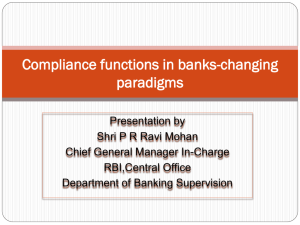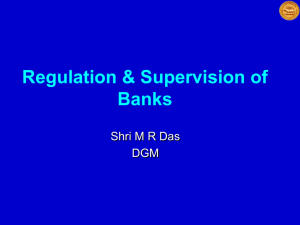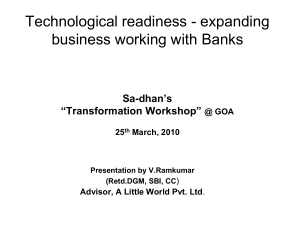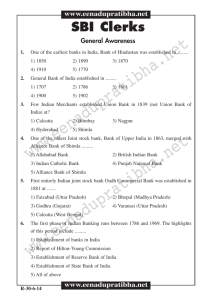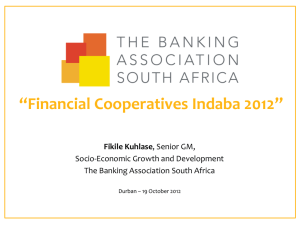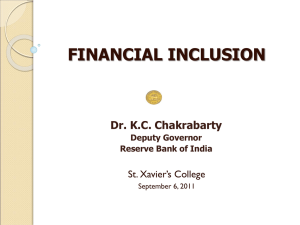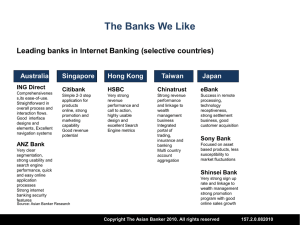Remarks at FICCI/IBA Annual Banking Conference
advertisement
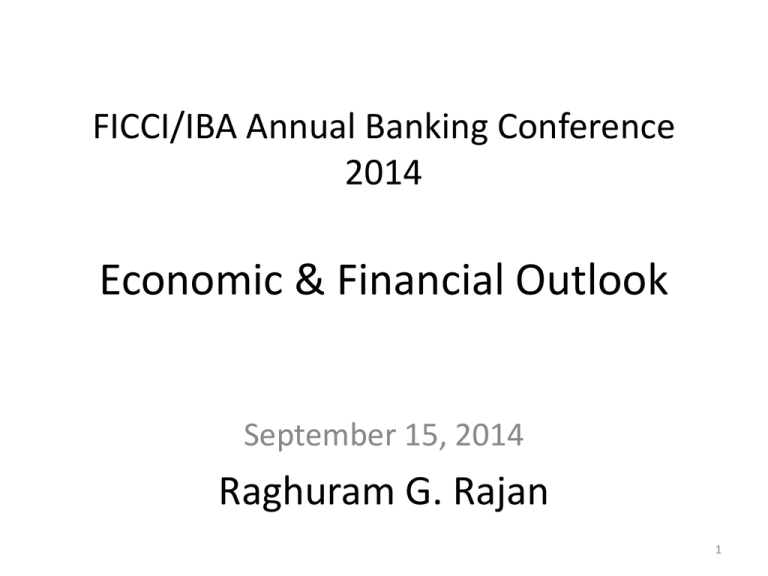
FICCI/IBA Annual Banking Conference 2014 Economic & Financial Outlook September 15, 2014 Raghuram G. Rajan 1 Outline • • • • Macroeconomy Changes in Banking Sector Developments in Financial Inclusion Two recent regulatory decisions that should be explained • Conclusion 2 Macroeconomy • World economy picking up hesitantly – Nearing the resumption of the rise in interest rates in industrial countries – Could be slower than warranted by domestic conditions – differentiated situations and exchange rate effects – Lower oil prices are helping consuming countries • Lower CAD and stronger rupee • Lower oil subsidies – need to seize the moment and eliminate diesel subsidies • Lower inflation – Geo political risk abounds: Ukraine, Middle-East 3 Macroeconomy • Domestic economy – Stable government makes us stand out relative to emerging market peers. – Recovery still uneven – industrial production especially durable consumption goods. But auto sales? – Monsoon strengthened in September, perhaps too much unfortunately in J&K. – Exports strong. – Need investment – why credit growth does not give full picture. – Inflation coming down, consistent with our forecasts. – Bottom line: Macro-indicators improving but still some way to go. 4 Changes in Banking Sector • • • • 2 new universal banks, more to come. Payment banks, small banks, PPI providers. Mobile-bank alliances: USSD technology. Business correspondents liberalized – NBFCs – Distance criteria 5 Changes in banking sector • Large firms using markets and external borrowing. Shift focus to: – MSME • Receivables Exchange – Retail • Bharat Bill Payment System • Large Projects and Infrastructure will pick up: Key contribution of banks -Project evaluation, financial structuring, and monitoring. – Better evaluation – In-house skills not intermediaries. Engaged, not lazy, banking. – Better structuring – more genuine equity, longer payback, financed with long term debt: recent RBI relaxations. – Better monitoring – early recognition of diversion or distress, quick coordinated action, effective project restructuring. • ARCs – Selling loans post construction – credit enhancement through liquidity facilities. 6 Changes in Banking Sector • NPAs have increased. – Significant portion in large infrastructure projects especially in PSBs. – Bad economy, poor structuring, slow down in government. – But also, allegations of malfeasance – Syndicate Bank. – Lots of good people in PSBs, but need to root out bad apples, bad practices, and weak capabilities. 7 Changes in Banking Sector • Governance Reform in PSBs (Nayak Committee): – Splitting Chairman and CEO – Lengthen CEO tenure – Change appointment process and talent pool for management and boards of PSBs – Strengthen board oversight and powers and allow it to hold management accountable • Focus of boards on important issues • Compensate board members adequately – Human resource development through pay, incentives, and skill building – Role for Lateral Entry – Cut costs – Allow PSBs independence to make commercial decisions – government mandates should be backed by financial payments: • Infrastructure • Branch opening 8 Developments in Financial Inclusion • Biggest recent development is Pradhan Mantri Jan Dhan Yojana. • Why universal financial access is a national priority: if every Indian household is connected to the financial system: – Increased financial savings – Direct benefits transfer: Less leakage, less price distortion, more empowerment – Less cash economy -- Rupay • Targets: Universality, not just speed or numbers essential. – – – – Waste if duplicate accounts Waste if not full coverage Waste if accounts not used Will work with banks to ensure effectiveness 9 Developments in Financial Inclusion • Equally important for financial inclusion – Customer grievance handling: especially important for very poor • Control over BCs essential • RBI Code of conduct will have teeth – Customer literacy • Not just camps handing out material • Closer engagement on inculcating savings, investment, and security habits, and even basic business sense • Work with NGOs, NABARD 10 Developments in Financial Inclusion • Many sectors in the economy get too little credit. Solution is to develop the financial framework across the board. • Less effective: – Offer interest subventions: Interest subventions distort the price of credit and lead to misuse. – Waive loans instead of improving the incomes of borrowers through better governance. – Promise easier credit to particular sectors: • Should a student loan for study abroad come under priority sector? 11 Two recent regulatory decisions • ATM fees: – RBI mandated 5 transactions per month free at any ATM. – Cost your bank – approx Rs.75 – because it had to pay the bank where you did the transaction. – No such thing as a free transaction. – Since this increases your bank’s costs, it is passed back to the customer in some form. – Ultimately, those who transact more are subsidized by those who transact less. • Should RBI mandate such cross-subsidy? • Are we also not subsidizing the use of cash? • Partial and very measured withdrawal of mandate in areas that are likely to be well-served by banks. • No compulsion on banks to charge. 12 Two recent regulatory decisions • Two factor authentication: – Introduced two factor authentication on credit cards. – Recently told firms who are by passing this, and indeed clearing transactions abroad, that they were contravening rules. – RBI against innovation? – Rule of law means we should enforce the rules on the books, not allow them to be violated just because the innovation is “cool”. 13 Two recent regulatory decisions – Why two factor authentication: Two-factor is innovation, has enhanced peace of mind even if not universally well used. • • • • • • • • Bank had not moved to two factor. Lady whose credit card was stolen. Tried contacting bank. Bank line busy. Filed police complaint . Large losses, who bears? People more at margin, less trained to be secure. Unless providers willing to accept liability for losses… Don’t take innovation in the West and say it should be implemented here unquestioningly. Take the totality of our systems into account. – Can we do better? Of course. We also are adapting to innovation. • Working to allow easy use for small value payments. • Provider has systems to protect against misuse. • Provider bears costs if misused. 14 Conclusion • We are in the process of picking up growth, even if the journey is likely to be bumpy at times. • Inflation is coming down, consistent with our forecasts. • Many opportunities in the banking sector, but also challenges. • These are exciting times for banking in India. 15

